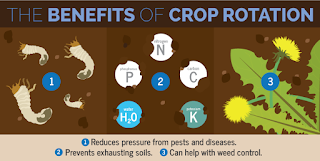Crop rotation: Crop choice of Legumes
Crop rotation: Crop choice of Legumes
Leguminous plant are belong from family of Fabaceae. Generally, legume plant is well known as being able to utilize the atmospheric nitrogen and important plant in crop rotation. It is because when legumes are grown as rotation crop,
it reduces the total grain production per farm when compared to continuous
cropping. Legume is giving the great advantage of crop rotation in term of crop
rotation from the terms of interrelationship of nitrogen-fixation with nitrogen
demanding crops. Examples of legume plant for crop rotation are soybean, groundnuts and peas.
Farmers know that the value of growing legume along with their
main crops or between harvest. Legume can replace the nitrogen used by the crop
and provide a cover for the soil in order to protect it from the heavy rain and
strong winds. Besides the legume tree planted at field also provide shade and
protect young crop plants from the heat of sun. Furthermore, legumes have
heavy tap roots that burrow into the deep ground and absorb the water. Some of the tap root can reach 1.50 m depth.
Nitrogen-fixation by Legume
The legumes produce the nitrogen through a process that involve the bacteria in the soil and nitrogen in the air. The bacteria form the small growth on plant roots that called nodules. If you look carefully at root of bean plant you will see the small swelling, that is nodules. The role of legume is carry out by the bacteria on the nodule that takes nitrogen from the air and fixes it into the soil. Nodules change the nitrogen into ammonia, in form of nitrogen that plant can use and this process is call nitrogen fixation.
 |
| Figure 2 |
 |
| Figure 2: nitrogen cycle |
Through this plant root nodule can
become source of nitrogen for legume which mean legume tend to be high in
protein. In crop rotation legumes are often utilized. By alternate the legume
and non-legume crop it can make the soil gain sufficient amount of usable
nitrogen utilize from the legume. In simple way, when the non-legume crop being
harvest and remove from the soil together with the nutrient and leaving the
soil with less nutrient. So, legume help keep the usable nitrogen in the soil
even after they are harvested. This process helps in sustain the usable
nitrogen concentration in soil for future crops.
Prepared
by:
Afiqah Liyana Binti Arzami ( 2018206966)
References:
· Katelyn
Ivers. Benefits of legume in agriculture and crop rotation from
·
Steve
Ember. Legumes: Good for people and soil
· Tilpati.
What are leguminous plants?





Cropsss
ReplyDelete